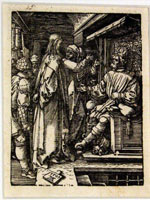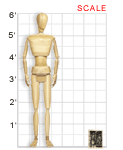VAM galleries including this work:
Clara M. Eagle Gallery, Murray State University | World of the Spirit || VAM Home
Albrecht Dürer (German, 1471-1528)
CHRIST BEFORE HEROD, 1509
Woodcut; 5" X 7"
1985.2.5
Clara M. Eagle Gallery, Murray State University
While Albrecht Dürer was a brilliant painter, he is perhaps most widely known for his masterful printmaking. Christ Before Herod is a woodcut print from Dürer’s series The Small Passion, which outlines the life and sufferings of Jesus. Because his depictions of Jesus are often strikingly similar to the artist’s self-portraits, art historians have long pondered Dürer’s motivation for creating a parallel between himself, the artist, and Jesus Christ, the Savior. Dürer’s distinctive signature, the initials “AD,” is conspicuously displayed on the tablet on the floor next to Christ’s foot.
About the Artist
Albrecht Dürer, one of the most outstanding Northern European figures of the Renaissance and in the history of art, was born in Nuremburg, Germany, in 1471. He was taught the art of silverpoint drawing as a young boy by his father, a Turkish goldsmith and jeweler. In 1484, Dürer began an apprenticeship under renowned artist Michael Wolgemut.
Eventually, Dürer’s artistic abilities surpassed those of his teacher, and he left for Italy to continue his training. Studying the works of Giovanni Bellini, Andrea Mantegna, and Leonardo da Vinci, the German artist was influenced by the style and theory of the Italian Renaissance artists. Dürer was a firm believer in the teachings of Martin Luther, and his evolving religious beliefs also affected his artwork, which became more severe in both subject and style around the year 1520. Dürer died in his hometown on April 6, 1528.
Classroom Ideas
Discussion: If you didn’t know the title of this print, would it still be evident that it is a religious work? Why or why not? What conventions has Dürer used to achieve a sense of depth in this woodcut? How would the use of color alter the mood of this work?
Discuss self-portraits. Why do you think so many artists create them? What are some ways an artist could “model” for a self-portrait? View images of some of Dürer’s self-portraits and other self-portraits online.
Activities: Hatching, which is particularly important in graphic works, is the use of fine parallel or crossed lines to create shading in an artwork. Study Dürer’s use of hatching in Christ Before Herod, then look through the Kentucky Virtual Art Museum collections to find examples of hatching in the works of other artists. Practice making your own marks until you feel like you have an understanding of how hatching is used. Then, looking at your reflection in the mirror, use a soft graphite pencil and a large sheet of drawing paper to create a self-portrait with hatching as your only form of shading. When you finish, discuss whether this technique was easier or more difficult than you thought it would be. How does it change the appearance of a work?
Links
View and read about Dürer’s Passion series at the Harvard University Art Museums.
[www.artmuseums.harvard.edu/publications/exhibitioncats/durer.html]
A detailed biography of Dürer, illustrated with chronological artworks and linking to sources of relevant information, is available from the University of St. Andrews.
[www-groups.dcs.st-and.ac.uk/~history/Mathematicians/Durer.html]
Visit the Web Museum, Paris for information about Dürer and images of his works.
[www.ibiblio.org/wm/paint/auth/durer/]
Nearly 70 images of Dürer’s artworks can be seen in Olga’s Gallery.
[www.abcgallery.com/D/durer/durer.html]
Numerous images can also be found on the Metropolitan Museum of Art’s Timeline of Art History.
[www.metmuseum.org/toah/hi/hi_dual.htm]
For a comprehensive list of Internet resources, check the Dürer entry in the Artcyclopedia.
[www.artcyclopedia.com/artists/durer_albrecht.html]
Learn about printmaking, step by step, at the Museum of Modern Art’s What Is a Print? site.
[www.moma.org/exhibitions/2001/whatisaprint/print.html]

